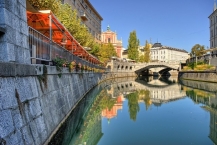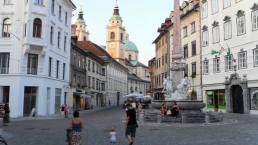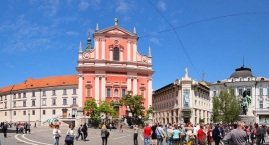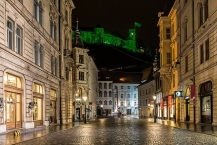Radtour Erasmus 2015 - back home- Trieste--Maribor
Geplante Tour
Aktionen
![]()
Bitte warten - Kartendaten werden geladen
Erstellt am 08.06.2015,
zuletzt geändert von margritundmarkus am 31.08.2016
Aktionen
Strecken-Merkmale
geplant
gefahren
Gesamtlänge in km
369
0
Gesamthöhenmeter Aufstieg
7.989
0
Durchschn. Steigung Aufstieg %
2,17
-
Gesamthöhenmeter Abstieg
7.743
0
Informationen zu Rechten an den GPS-Track-Daten | |
|---|---|
Rechte-Inhaber | |
Rechte-Ausprägung / Lizenz | by-sa: CREATIVE COMMONS Namensnennung, Weitergabe unter gleichen Bedingungen |
Link zur Rechtebeschreibung | |
gpx-Datei hochgeladen | durch Manuel90 am 08.06.2015
|
Gesamtzahl Trackpoints
7.008
0
Trackpoint-Dichte per km
19
0
Endorte
Start
Piran / Pirano, SI (16 m NHN)
Ziel
Maribor, SI (263 m NHN)
Fahrradfreundliche Unterkünfte, Sehenswertes und Infrastruktur
Name u. Anschrift
Breite / Länge
Tel.
Fax.
Mobile
Art d. Unterkunft
Radler-freund-lichkeit
Strecken-km
km zur Strecke
Höhe
3 km
2,5 km
122 m
131 km
0,1 km
543 m
193 km
0,0 km
293 m
Öffnungszeiten
Open from Monday to Friday 9:00 - 17:00, Saturday 9:00 to 16:00, Sundays and public holidays 9:00 to 13:00
193 km
0,0 km
305 m
Informationen zu Urheber-Rechten | |
|---|---|
Rechte-Inhaber | |
Rechte-Ausprägung / Lizenz | by-sa: CREATIVE COMMONS Namensnennung, Weitergabe unter gleichen Bedingungen |
Link zur Rechtebeschreibung | |
Bild übernommen aus | |
Bild hochgeladen | durch biroto-Redaktion am 15.01.2022
|
Informationen zu Urheber-Rechten | |
|---|---|
Rechte-Inhaber | |
Rechte-Ausprägung / Lizenz | by-sa: CREATIVE COMMONS Namensnennung, Weitergabe unter gleichen Bedingungen |
Link zur Rechtebeschreibung | |
Bild übernommen aus | https://commons.wikimedia.org/wiki/File:Ciril-Metodov_Trg.JPG |
Bild hochgeladen | durch biroto-Redaktion am 15.01.2022
|
Informationen zu Urheber-Rechten | |
|---|---|
Rechte-Inhaber | |
Rechte-Ausprägung / Lizenz | by-sa: CREATIVE COMMONS Namensnennung, Weitergabe unter gleichen Bedingungen |
Link zur Rechtebeschreibung | |
Bild übernommen aus | https://commons.wikimedia.org/wiki/File:Ljubljana_-_Prešeren_Square2.jpg |
Bild hochgeladen | durch biroto-Redaktion am 15.01.2022
|
Informationen zu Urheber-Rechten | |
|---|---|
Rechte-Inhaber | Aleš Kravos |
Rechte-Ausprägung / Lizenz | by-sa: CREATIVE COMMONS Namensnennung, Weitergabe unter gleichen Bedingungen |
Link zur Rechtebeschreibung | |
Bild übernommen aus | https://commons.wikimedia.org/wiki/File:Ljubljana_stritarjeva_ulica.jpg |
Bild hochgeladen | durch biroto-Redaktion am 15.01.2022
|
Ljubljana [ljuˈbljàːna] is the small but delightful capital of Slovenia. While the whole city has grown to a population of 295,500 in 2020, the sights and amenities are concentrated in the charming old centre. It's full of artists, museums, and galleries, it's friendly and easy to reach, and it's a good base for exploring the rest of the country.
Understand
Ljubljana stands at the entrance to a plain in an otherwise mountainous region, the confluence of several river valleys, so it's been a focus for settlement, trade and transport since prehistory. The first known city was the Roman Colonia Iulia Aemona; in medieval times it became Laibach and this name is still used by some German-speakers (as well as modern Slovenia's most notable cultural export, the band of that name). It fell under the gravity of Austria-Hungary and was a duchy or province of the Hapsburg Empire until 1918. For much of the 20th century it was part of Yugoslavia until independence in 1991. This means that Ljubljana has simply been a regional capital, and has only been the national capital of a relatively small country for a few decades. The city landscape reflects this: it's compact and walkable, cosy and friendly, rather than grandiose. There are no vast ceremonial boulevards, bling palaces or imperial fists of fortification. It's not a place where you hop around ticking off must-see sights, like a bug with a selfie-stick for antennae. Relax, stroll and enjoy the atmosphere.
No-one really knows how its current name came about: it resembles ljubljena - "beloved" - in Slovenian, but that seems to be just a happy coincidence. It sits in the valley of the Ljubljanica river, with green hills hemming it in on either side. The river makes a right angle, with the castle and oldest parts of the city on the hill in the southeast quadrant. A 19th century street grid extends north of the river, then the modern town sprawls to the west and north. Three natural disasters shaped the city architecture. An earthquake of 1511 caused extensive re-building in Renaissance style, and in stone to curb the fires of the wooden city. Another earthquake in 1895 prompted rebuilding in Vienna Secession style. It was flooded by the river multiple times until the Gruber Canal was cut across the southeast quadrant in the 18th century, turning the castle hill into an island. Therefore the main flow bypasses the old centre, which was protected from the devastating 2010 floods of the Danube catchment region. The "Triple" and "Dragon" bridges stand intact as proud symbols of Ljubljana.
Ljubljana is a year-round destination but you need to dress for the Balkan climate. Summers are warm, with daytime highs of 30°C. There are often public events and festivals, with streets converted from traffic thoroughfares to event spaces, but afternoons can be humid with thunderstorms and downpours. Early summer and autumn enjoy more even temperatures, and there's a student buzz as the university is in session. In winter it's near-zero, often with snow, and biting winds off the hills, but as Christmas approaches the streets are decorated by thousands of lights, and food and drink kiosks pop up along the river bank. February is grey, before in spring the city blooms with flowers planted on its streets and crossroads.
See
In 2021, seven works in Ljubljana by architect Jože Plečnik were inscribed on the UNESCO World Heritage List. These are the Trnovo Bridge, the green promenade along Vegova Street, the promenade along the embankments and bridges of the Ljubljanica River, the Roman walls in Mirje, the Church of St Michael, the Church of St. Francis of Assisi and the Garden of All Saints (Plečnik’s Žale).
- ⊙Triple Bridge (Tromostovje)
is at the heart of the old city. The central span is from 1842: it became a bottleneck so in the 1930s footbridges were added on each side, fanning out slightly. On the north bank these lead into Prešeren Square, adorned by the statue of the national poet France Prešeren (1800-1849). It's the obvious rendezvous point in town; the area is pedestrianised. The TIC is south end of the bridge.
- ⊙Old Town. Squeezed between the castle hill and Ljubljanica river is the old town with two squares, Mestni trg (City square) with the Robba fountain and the city hall behind it, and, further on, Gornji trg (Upper square). Well preserved medieval buildings now house local designer shops, and several popular cafes and restaurants. Although they may look creepy, the perfectly safe narrow lanes lead to charming little squares and buildings.
- ⊙Dragon Bridge (Zmajski Most). Completed in 1901, designed by Croatian Jurij Zainovich. It is guarded by four detailed dragon statues from the city's coat-of-arms. Look out for the dragon motif throughout the city. Be careful around the Dragon Bridge area, as it is on a major busy road just outside the pedestrian zone and near misses (and worse) between inattentive tourists and traffic are common. The dragon bridge is located at the end of the Ljubljana Open Market, just a block or two down the river (north-east direction) from the Triple bridge.
- ⊙Ljubljana Castle (You can catch the funicular or walk up). The tower has magnificent views all over the city. You can also see the Sava River and Kamnik Alps in the distance. Included is a 3D Movie of the history of Ljubljana from a pre-historic settlement to Roman Empire
 to modern times (€6.50 for adults, €3.00 for students, seniors). Entrance to the Castle Courtyard, Chapel and Gift shop is free, but there is a charge for access to the tower.
to modern times (€6.50 for adults, €3.00 for students, seniors). Entrance to the Castle Courtyard, Chapel and Gift shop is free, but there is a charge for access to the tower. - ⊙Square of the Republic. Where crowds gathered as Slovenia announced its independence from the Yugoslav Federation in 1991. The square has significant importance for Slovene history, as it was a place of important public gatherings (and demonstrations) in the past. Across the road is the Slovene Parliament. Its façade is decorated with artistic nude statues of Slovenes at work and leisure. The square also houses the International Business Centre.
- ⊙Roman Ruins. A short walk west of the centre of town are the remains of the Roman City Walls, including a number of pillars from an entrance gate.
- ⊙Krakovo. A village-like part of the city connecting the centre to the Trnovo suburb.
- ⊙Metelkova City. A self-declared autonomous culture place to gather for alternative artists, many subcultures and youth. What used to be a military barracks is now full of underground artists, bars and nightclubs. Metelkova can get crowded on Fridays and Saturdays. It is within 5 minute of walk from main Train Station, and it is home to a renowned hostel Celica.
- ⊙Tivoli Park
to the west is the city's main park, with a large pond at its southwest end and the hill of Rožnik behind.
- ⊙University Botanic gardens Ljubljana, Ižanska cesta 15, ☎ +386 1 427 1280. open daily, Apr–Jun 07–19, Jul–Aug 07–20, Sep–Oct 07–19, Nov–Mar 07–17. Tropical glasshouse has reduced hours: daily 10:00–16:45. Ljubljana Botanic Garden is the oldest Slovene cultural, scientific and educational institution. It was founded in 1810, the time of the Illyrian Provinces, as a garden of native flora and a section of the Central School (École Centrale). In the garden is also tropical glasshouse. gardens free, tropical glasshouse €2.80.
- ⊙Tomb of National Heroes. a tomb and a monument for the national heroes of the World War II resistance struggle in Slovenia, created in 1949.
- ⊙Ursuline Church of the Holy Trinity. A Baroque style church built between 1718 and 1726.
- ⊙Congress Square (Kongresni trg). One of the central squares, built in 1821. In 1988 the first free mass demonstration was held here, which was the start of the Slovenian spring, leading to the declaration of Slovenia's independence in 1991.
- ⊙Nebotičnik. A 13 storey high-rise.built in 1931, designed by Vladimir Šubic, with a cafe & bar on the top floor.
- ⊙Sts. Cyril and Methodius Church (Cerkev sv. Cirila in Metoda). An Orthodox Church has five domes with golden crosses at their top. It was built from 1932 to 1936, with interior frescos painted between 1986 and 1997.
- ⊙Franciscan Church of the Annunciation (Frančiškanska cerkev Marijinega oznanjenja). Built between 1646 and 1660, with a later front facade and bell tower.
- ⊙Ljubljana Cathedral (ljubljanska stolnica). St. Nicholas's Church (cerkev sv. Nikolaja) was built between 1701 and 1706 on a site dating back to 1262. The fine interior includes fresco painted by Giulio Quaglio between 1703 and 1723.
Museums
- ⊙Architecture Museum of Ljubljana: Plečnik Collection, Karunova 4, ☎ +386 1 280 1600.An annex of the Architecture Museum devoted to great Slovenian architect Jože Plečnik, who lived in this building from 1921 to 1957. The house contains rooms with the artist’s valuable original furniture and personal objects, an archive of his sketches and plans and a collection of clay, plaster and wooden models, a library, Plečnik’s correspondence, a photo archive, thesis projects of Plečnik’s students and an archive of the Academy of Architecture Collection. Access only by guided tour of not more than 7 people, booked at least five days in advance.
- ⊙Museum of Modern Art (MG+), Cankarjeva cesta 15. Tu–Su 10:00–18:00. For those who prefer contemporary art, MG+ houses the national collection of 20th-century Slovene art (paintings, sculptures, prints, drawings, photography, video and electronic media collections), a collection of works from the former Yugoslavia, and the Eastern European collection "Arteast 2000+.". €5 adults, €2.50 students.
(updated Dec 2016)
- ⊙National Gallery, Prešernova 24. Definitely worth visiting if you care about art. It exhibits two important permanent collections that include works of some of the best and most renowned Slovenian (impressionist) painters (Jama, Grohar, Jakopic, Azbe). You can also see there a restored original of the Robba Fountain, a monument of national cultural heritage.
- ⊙National Museum of Slovenia - Prešernova, Muzejska ulica 1, ☎ +386 1 241 4400, .daily 10:00-18:00, Thursday 10:00-20:00, closed on public holidays.The oldest and the largest Slovene museum. It was founded in 1821. Existent museum building on the Museum street, was built in 1888 and was the first, building, assigned solely to culture in Slovenia. Today its stores a rich collections of valuable objects. The oldest spring back to the Stone Age, but there are also the newer ones, which are still used in our everyday life. Important columns of museum activity are also rich museum library and unit for preservation and restoring. Free admission each first Sunday of the month.
- ⊙National Museum of Slovenia - Metelkova, Maistrova 1, ☎ +386 1 230 7030, .Tu-Su 10:00-18:00, closed on public holidays.In the new building of the National museum of Slovenia on the Metelkova Street, are exhibited collections of the applied art heritage of Slovenia. The permanent exhibition brings together objects of applied arts from the 14th century to the present day.
- ⊙National Museum of Contemporary History, Celovška 23 (walk through the pleasant Tivoli park to get here.), ☎ +386 1 300 9610. Slovenia's 20th-century history museum gives you a real sense of the country's roller-coaster ride through regime after regime. Its immersive exhibits include a walk-through World War I trench. The last exhibit shows the events around the Declaration of Independence from Yugoslavia and the Ten Day War with the Yugoslav Federal Army. All exhibits are translated to English and some to German too.
- ⊙Slovenian Museum of Natural History, Muzejska 1, ☎ +386 1 241 09 70. F-W 10:00-18:00, Th 10:00-20:00. Features an almost complete skeleton of a 20,000 year old mammoth found near Kamnik in 1938, a 200-million-year old fossil fish skeleton found in Triglav National Park
 , and a new, 13-m skeleton of a fin whale. Also has a large mineral collection.
, and a new, 13-m skeleton of a fin whale. Also has a large mineral collection. (updated Nov 2016)
- ⊙Tivoli Gallery - International centre of Graphic Art, Pod turnom 3, ☎ +386 1 241 3800. Open Tu-Sa 10:00-18:00, Su 12:00-18:00. Specialised in art shows, often in collaboration with international institutions. Adults €5, families €9, other discounts apply.
(updated Nov 2016)
- ⊙City Museum of Ljubljana (Mestni muzej Ljubljana). Tu–Su: 10.00–18.00. City history and temporary exhibitions. 6€.
(updated May 2021)
Informationen zu Urheber-Rechten | |
|---|---|
Rechte-Ausprägung / Lizenz | by-sa: CREATIVE COMMONS Namensnennung, Weitergabe unter gleichen Bedingungen |
Link zur Rechtebeschreibung | |
Text(e) übernommen von: |
Wikivoyage contributors, 'Ljubljana', Wikivoyage, The FREE worldwide travel guide that anyone can edit, 10 December 2021, 21:46 UTC, https://en.wikivoyage.org/w/index.php?title=Ljubljana&oldid=4342939 |
übernommen / bearbeitet am | 15.01.2022
|
übernommen / bearbeitet durch |
|
289 km
2,8 km
238 m
Öffnungszeiten
Januar–April, Oktober, November: Montag–Samstag: 10:00–17:00, Sonntag & Feiertage: 10:00–13:00.
Mai–September: Montag–Samstag: 10:00–19:00, Sonntag & Feiertage: 10:00–13:00.
Sprachen:
slovenščina
![]()




